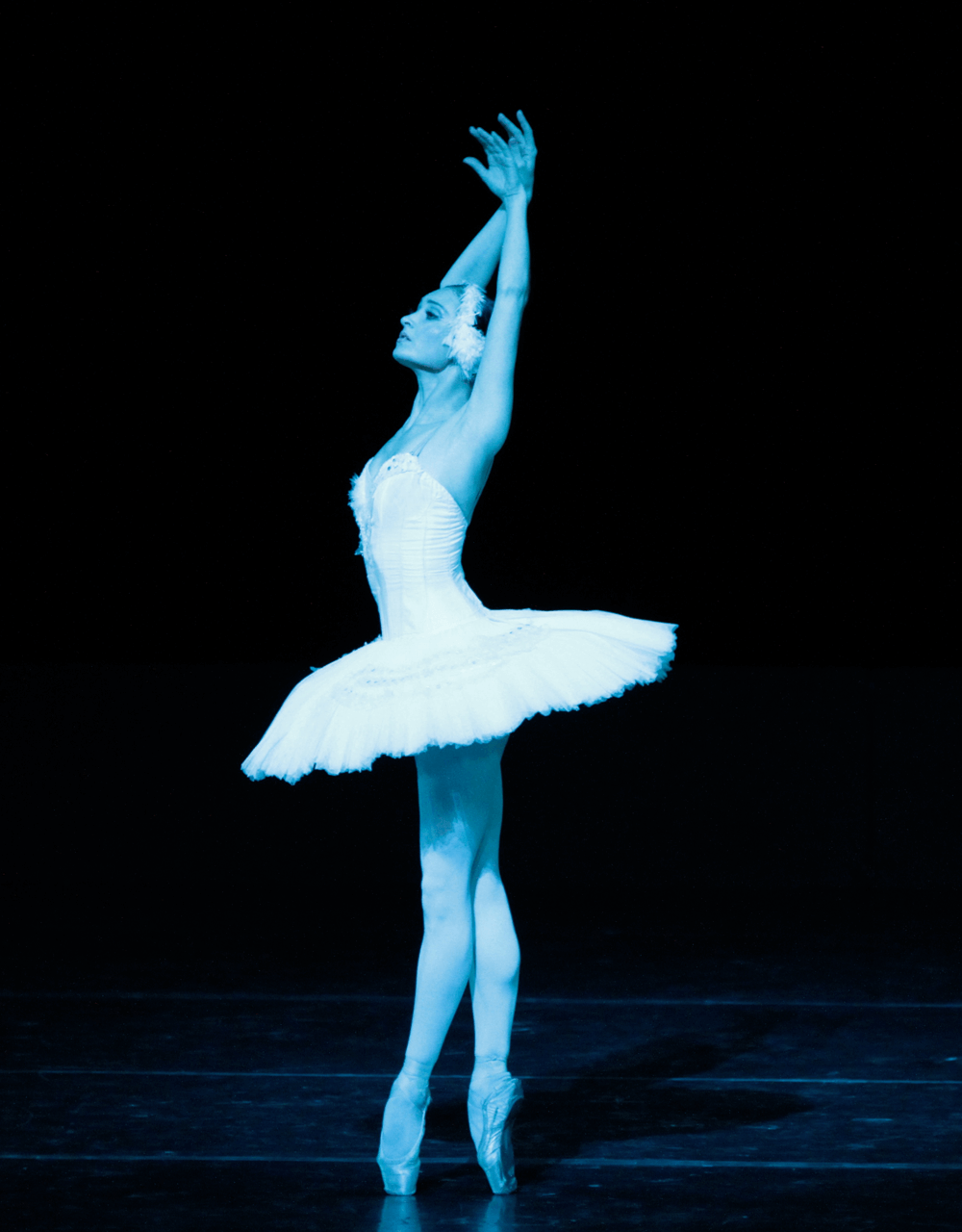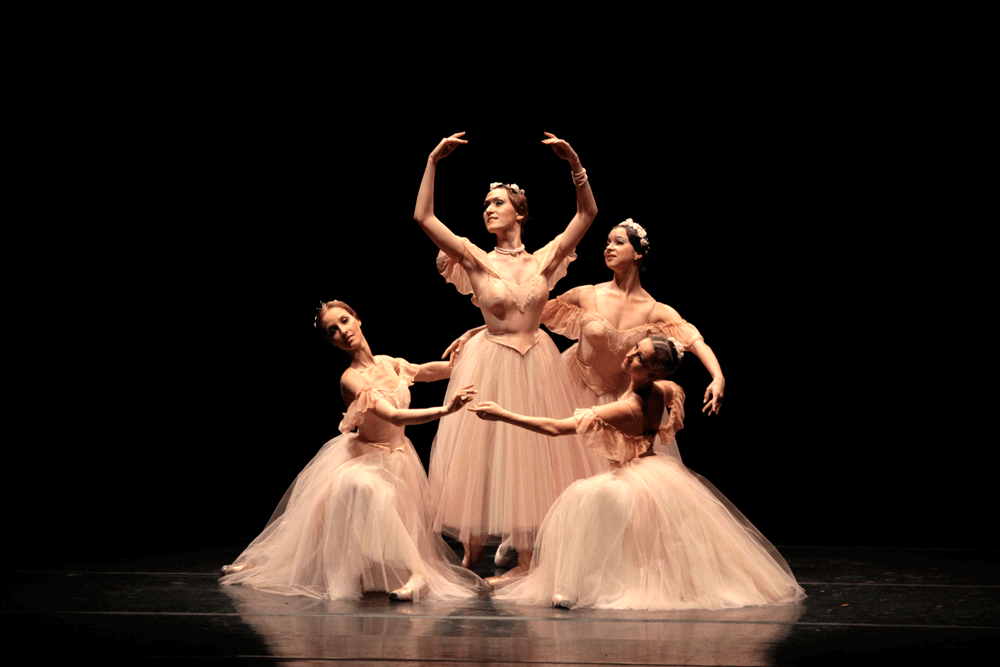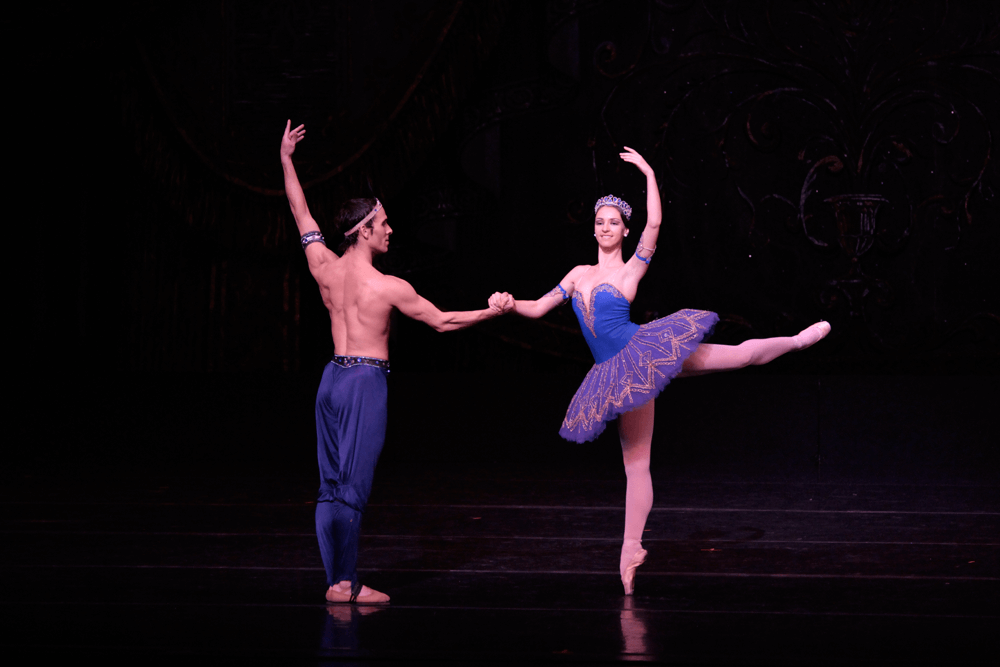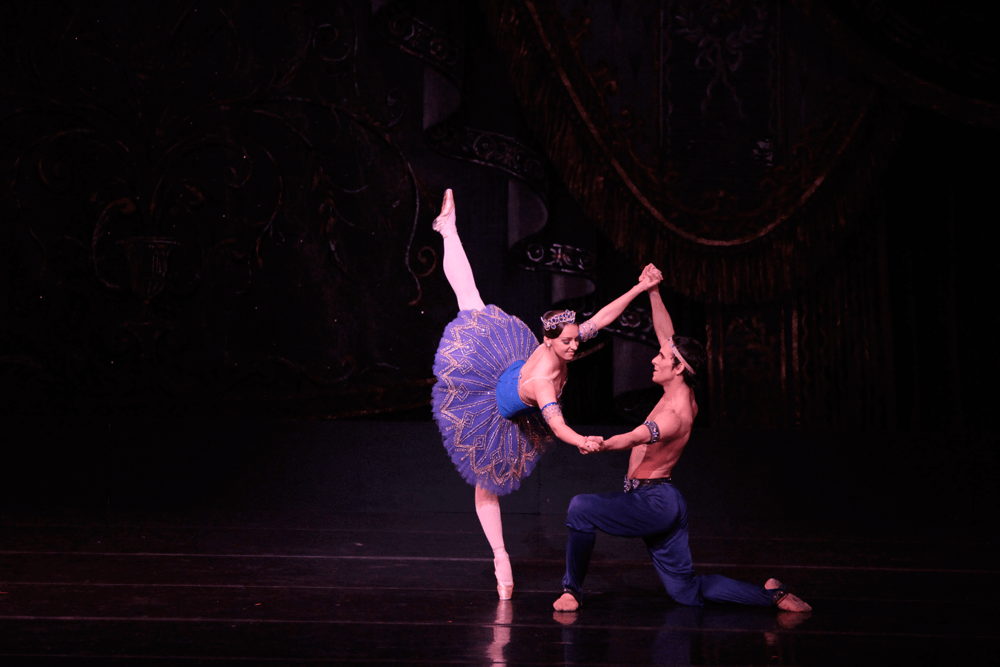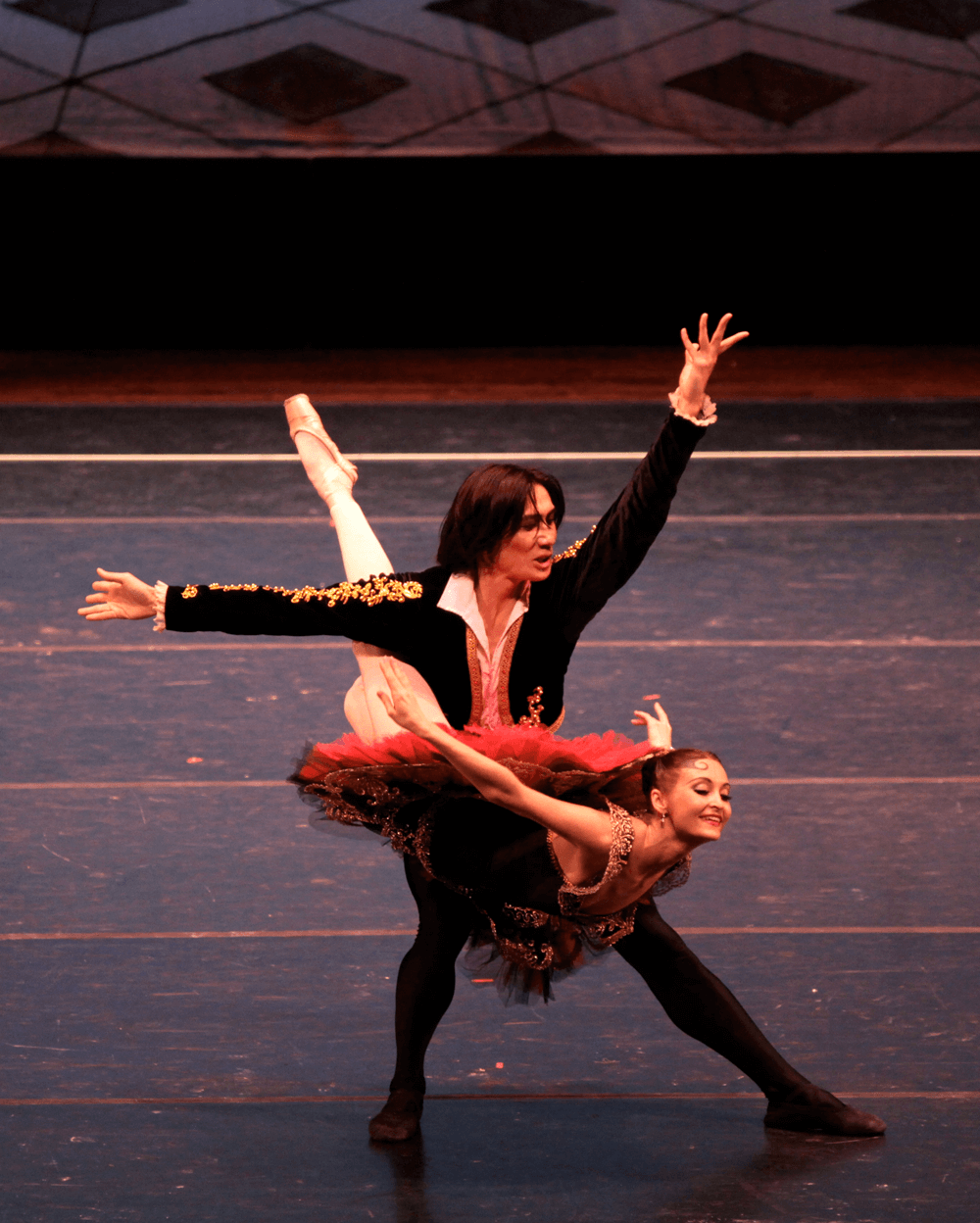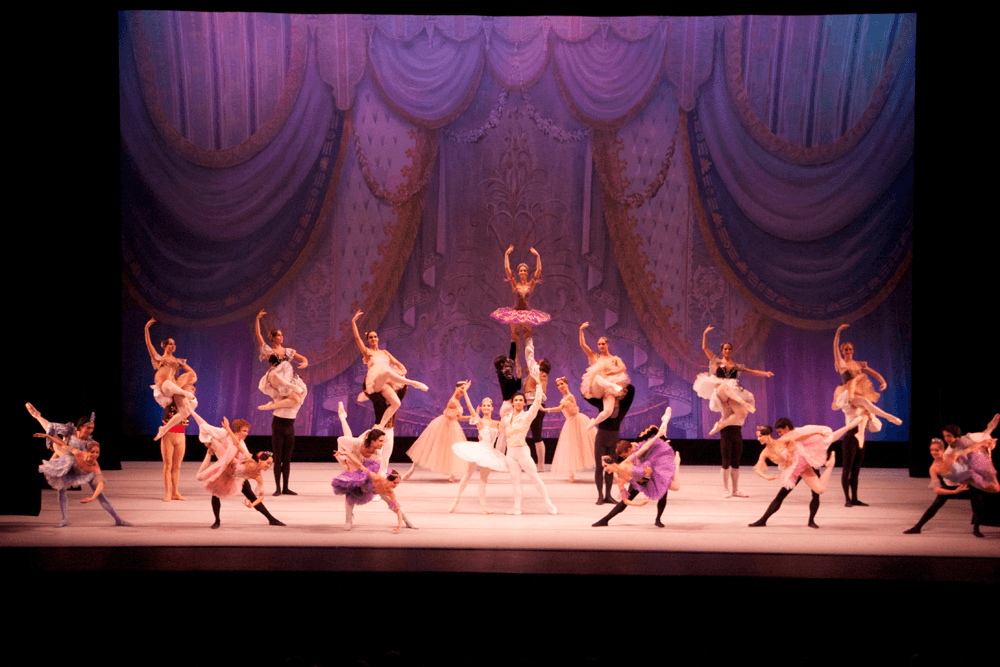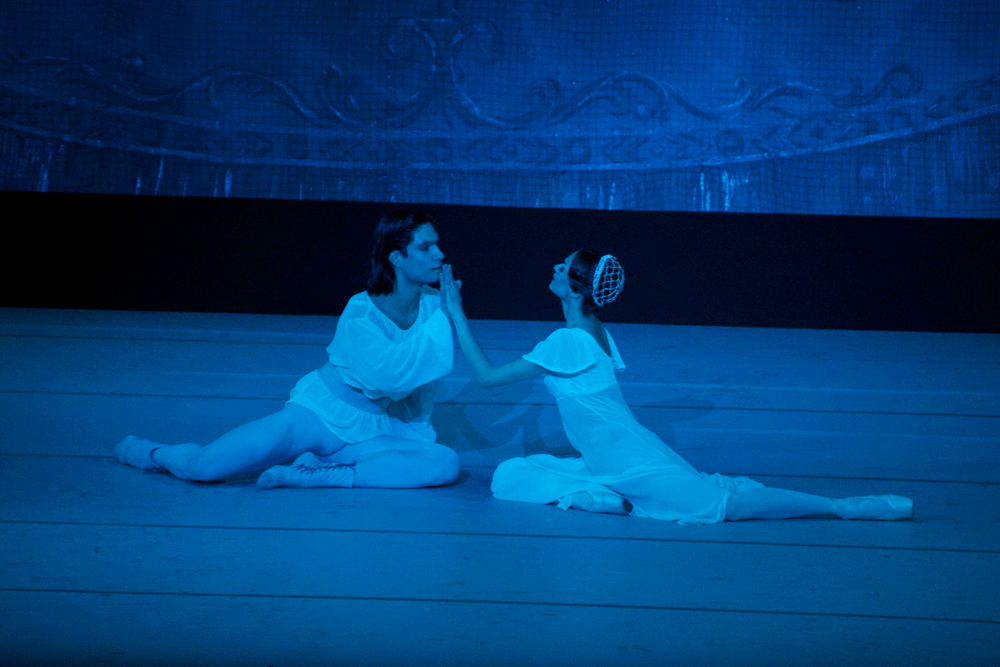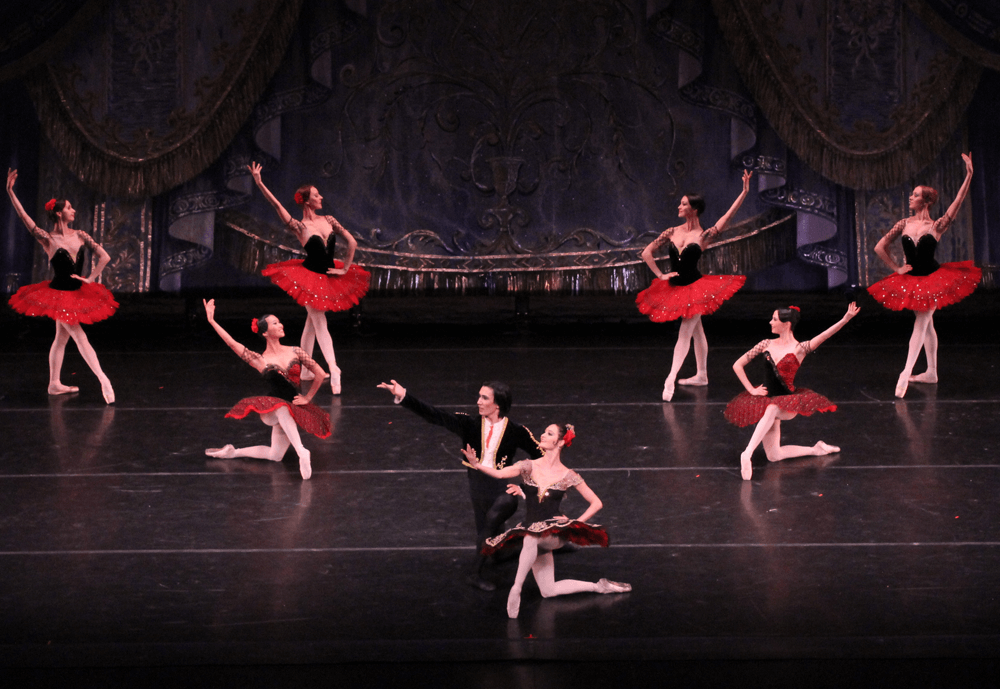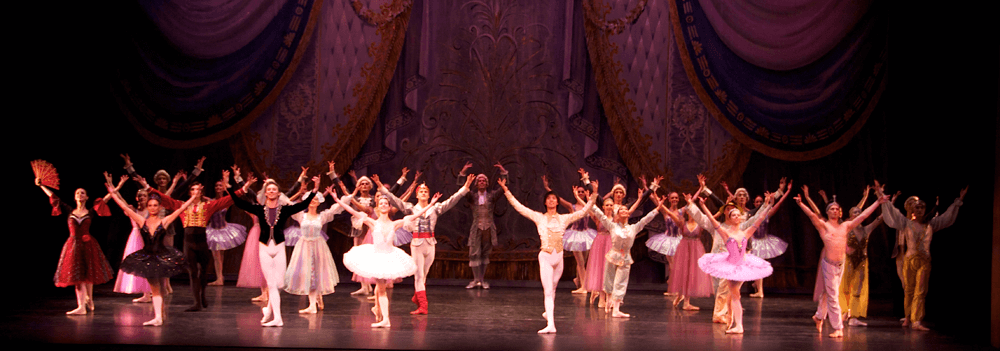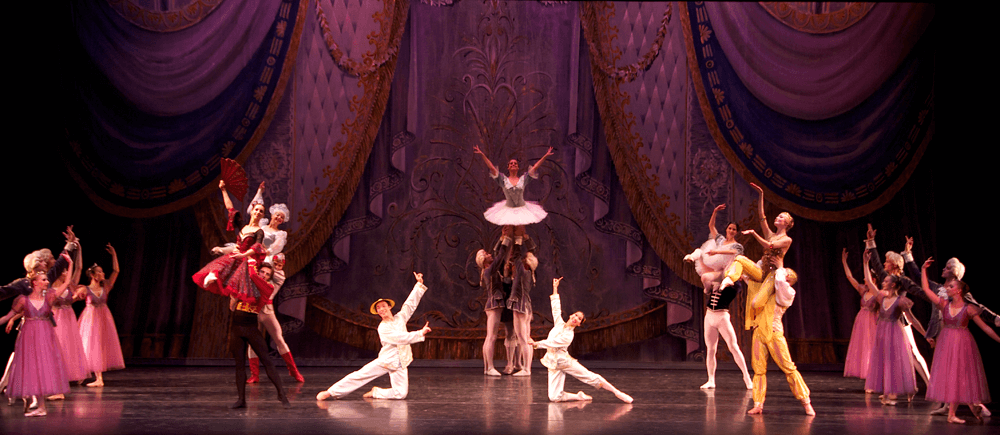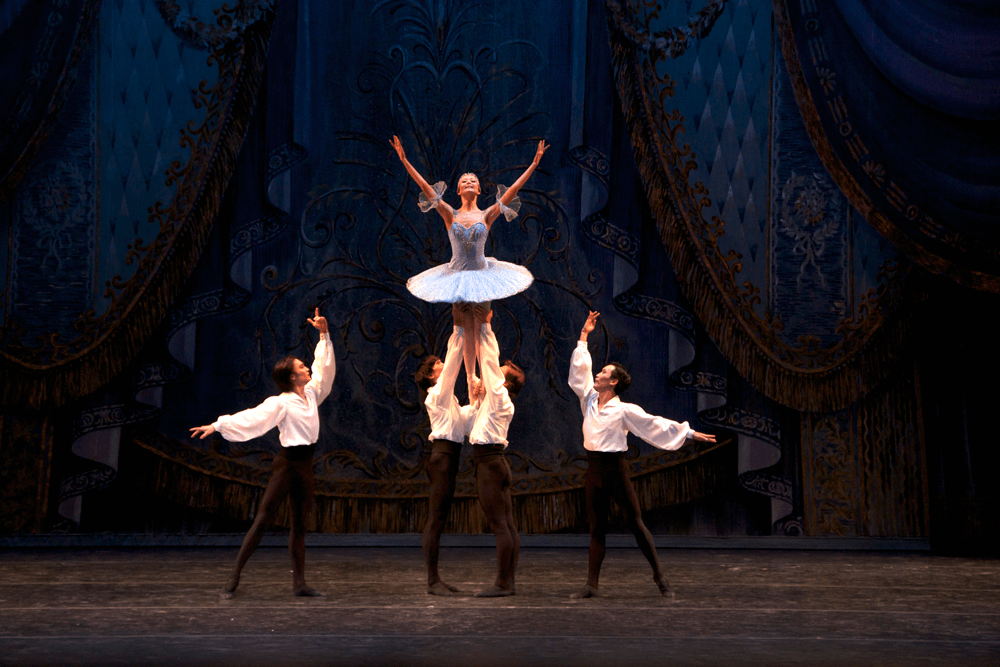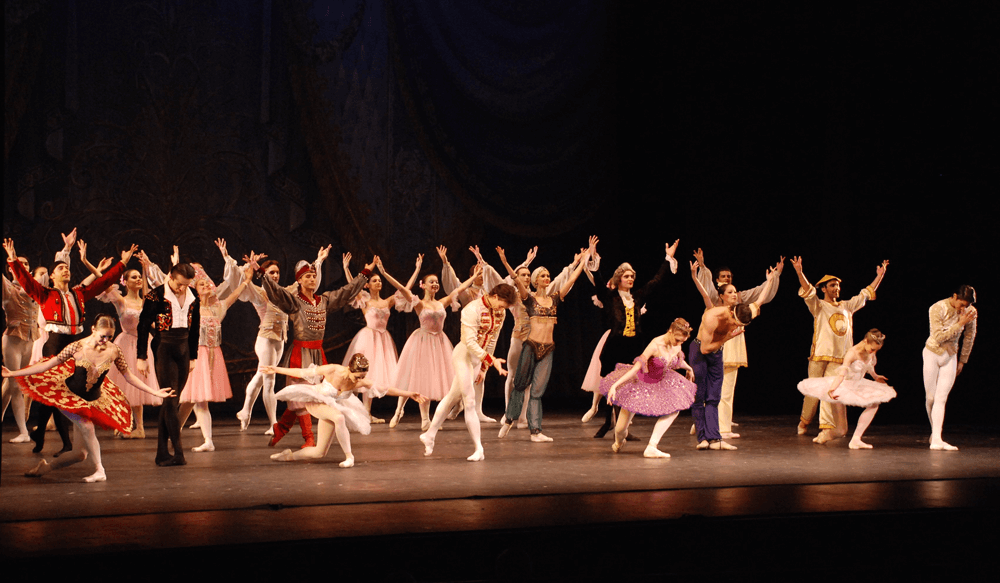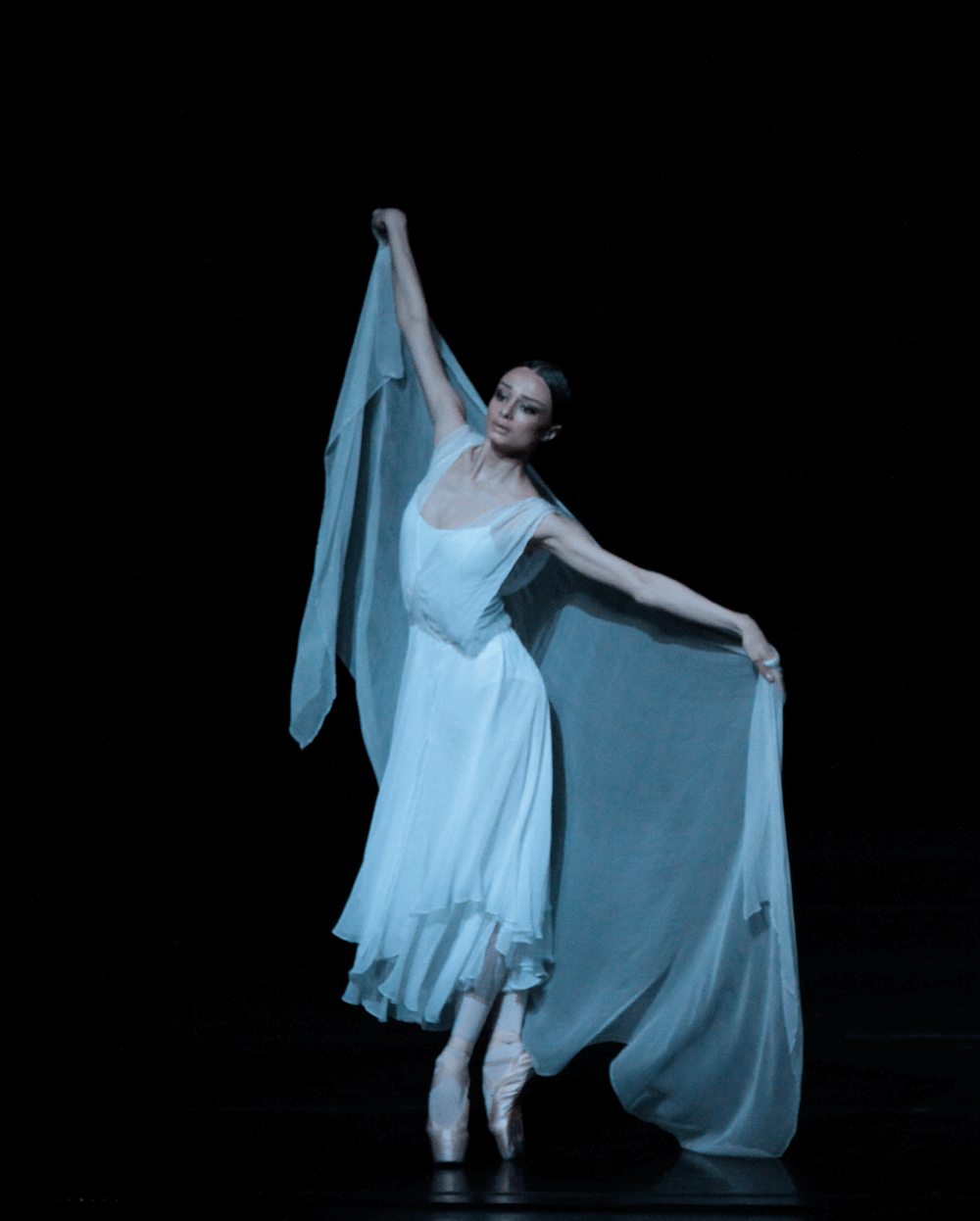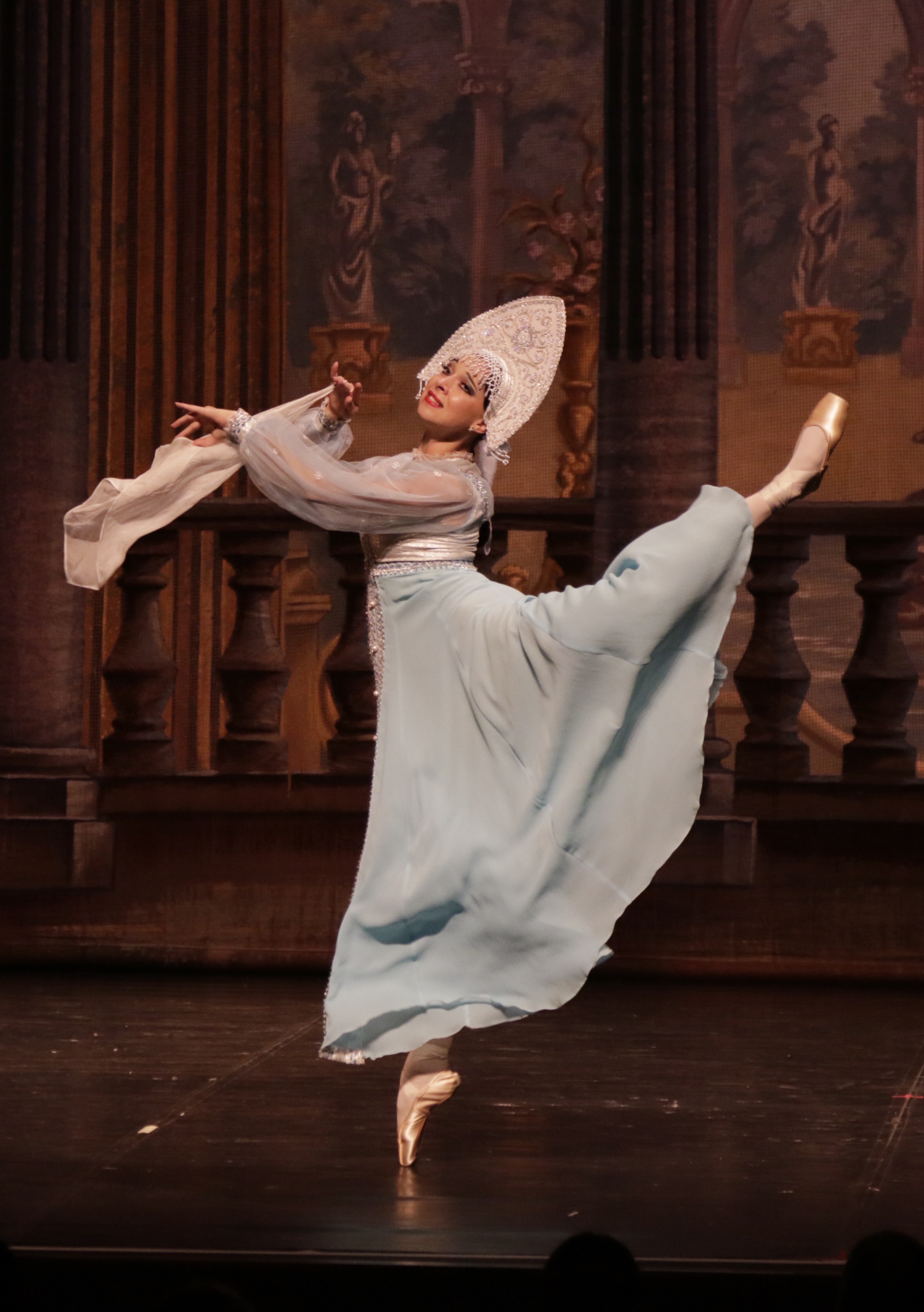Gala-program. Tchaikovsky Gala.
«STARS OF THE RUSSIAN NATIONAL BALLET» GALA PROGRAM
1. The Sleeping Beauty Act I The Rose Adagio
Music by Pyotr Ilyich Tchaikovsky
Choreography by Marius Petipa
Dancers: Ekaterina Egorova, Samat Abdrakhmanov, Azis Essembaev, Rastem Assanov, &
Zanat Chubanov.
2. The Ocean and the Pearls from The Little Humpbacked Horse
Music by Cesare Pugni
Choreography by Saint-Leon
Dancers: Maria Klyueva, Anna Petushinova, Samat Abdrakhmanov
3. The Quatre
Music by Pyotr Illych Tchaikovsky
Choreography by Elena Radchenko
Dancers: Anna Petushinova, Olga Gudkova, Nurlan Kinerbayev, Mikhail Mikhailov,
& Viacheslav Tapharov
4. Cinderella Act III Adagio
Music by Sergei Prokofiev
Choreography by Rostislav Zakharov
Dancers: Maria Sokolnikova, Constantine Marykin, Alexander Daev, & Mikhail Mikhailov
5. Adagio from Romeo and Juliet
Music by Pyotr Illych Tchaikovsky
Choreography by Elena Radchenko
Dancers: Ekaterina Egorova and Nurlan Kinerbayev
6. Don Quixote Act III Grand Pas
Music by Leon Minkus
Choreography by Alexander Gorsky
Dancers: Maria Sokolnikova, Aydos Zakan, Mikhail Mikhailov & the Corps de Ballet
-INTERMISSION-
7. Pas de Quatre
Music by Cesare Pugni
Choreography by Anton Dolin
Dancers: Ekaterina Egorova, Olga Gudkova, Elena Khorosheva, Eriko Naritake
& Daria Lednikova
8. Allegro
Music by Pyotr Illyich Tchaikovsky
Choreography by Vitaly Zabelin
Dancers: Katsiaryna Pankouskaya, Samat Abdrakhmanov, Anton Baglikov, Zanat Chubanov,
& Nurlan Kinerbayev
9. Dying Swan
Music by Camille Saint-Saens
Choreography by Michel Fokine
Dancers: Maria Sokolnikova, Ecaterina Egorova, & Olga Gudkova
10. Selections from Paquita
Music by Leon Minkus
Choreography by Joseph Mazilier/Marius Petipa
Dancers: Ekaterina Egorova, Aydos Zakan, Mikhail Mikhailov & soloists of the Russian National Ballet Theatre
The Rose Adagio from Act I of Sleeping Beauty
Choreograhy: Marius Petipa
Music: Pyotr Ilyich Tchaikovsky
The Sleeping Beauty, a ballet in a prologue and three acts with choreography by Petipa, had its first production in 1890 at the Maryinsky Theatre, St. Petersburg. In the last quarter of the nineteenth century, ballet on the Imperial Russian stage had sunk to a very low level artistically. The director of the Imperial Theatres, Ivan Vsevolojsky, a talented and cultured man, was determined to raise the artistic level on all counts, and as a first step he approached the composer Tchaikovsky to supply him with a ballet score. Owing to the slight success in Moscow of his previous attempts at ballet music (Swan Lake), it is not wholly surprising to find Tchaikovsky insistent on having minute and detailed instructions from the choreographer himself. These he followed slavishly, down to the exact number of bars required in a given scene or variation, which circumstance amazingly, far from shackling his imagination, seems positively to have inspired it, for the resulting enchanting score remains possibly his best ballet music.
The Rose Adagio of Act I of The Sleeping Beauty is one of ballet’s most iconic set pieces. The scene takes at the beginning of the ballet at Princess Aurora’s sixteenth birthday party. Celebrations are already underway: the atmosphere is festive, and Princess Aurora receives her four royal suitors and their gifts of exquisite roses. The music and choreography by which Princess Aurora is presented to her four suitors is as instantly recognizable as the Dance of the Little Swans in Swan Lake or the Sugar Plum Fairy in the Nutcracker.
The key fact about the Rose Adagio is its technical difficulty. After a sparky allegro entrance, the ballerina has to steady herself for a series of unsupported balances, taking off from each of her four princes in turn as Tchaikovsky’s music builds up to an expectant climax around her.
Marius Petipa (1818-1910), served as ballet master of the Imperial Theatre in St. Petersburg from 1862 to 1903, where he choreographed such classics as Don Quixote, The Sleeping Beauty, Raymonda and Le Corsaire. His work is considered one of the greatest achievements of ballet history.
The Ocean and the Pearls from The Little Humpbacked Horse
Music by Cesare Pugni
Choreography by Saint-Leon
Arthur Saint-Léon’s 1864 ballet «Le Petit cheval bossu, ou La Tsar-Demoiselle» («The Little Humpbacked Horse, or The Tsar Maiden») was based on Pyotr Yershov’s celebrated poem («Konyok-gorbunok», meaning «Hunchback Horse») and composed for the Imperial Ballet (today the Kirov/Mariinsky Ballet). The work premiered in December 13, 1864 at the Imperial Bolshoi Kamenny Theatre in St. Petersburg, Russia. The ballet was a massive success, with its fantastical tableaux set on an enchanted Isle of mermaids, or another set in a magical Under-water world. The ballet’s final act included a Grand divertissement celebrating the many peoples of the Russian Empire. Cesare Pugni’s music was equally successful, & was heard at Imperial Balls for decades thereafter. The resoundingly successful premiere was attended by Emperor Alexander II. The ballet lived on for many years in the repertory of the Imperial Ballet and the Kirov Ballet, and of the Bolshoi Theatre in Moscow in a version by Alexander Gorsky (1901). Marius Petipa revived the ballet in 1895 as The Tsar Maiden for the Ballerina Pierina Legnani. Alexander Radunsky choreographed his own version to a score by Rodion Shchedrin for the Bolshoi Ballet in 1960, a version which was filmed in 1961 with Maya Plisetskaya as the Tsar Maiden and Vladimir Vasiliev as Ivanushka. In 2009, Alexei Ratmansky choreographed a new version for the Mariinsky (Kirov) Ballet, also using Shschedrin’s score.
A version of Saint-Léon’s original was filmed in 1989 for Russian television with graduates from the Vaganova Academy of Russian Ballet in the lead roles. The film included narrated sections and illustration from a popular 1964 Russian version of Yershov’s book.
The Quatre
Music by Pyotr Ilyich Tchaikovsky
Choreography by Elena Radchenko
While Tchaikovsky is known for his composition of several glorious pas de deux in his prolific ballet works, little is known about his non-excerpted pas de deux. In this sensational display, Elena Radchenko has taken two of those pas de deux and choreographed them into a mélange of pure beauty and elegance.
Adagio from Romeo and Juliet
Music by Sergei Prokofiev
Choreography by Elena Radchenko
The ballet closely follows Shakespeare’s tragedy. There is an emphasis on the social conflict between the two feuding families from disparate social classes, who are reconciled over the tombs of the two lovers. This pas de deux is from the famous scene where Juliet dreams of Romeo outside on her bedroom balcony. He appears below in the garden. They declare their eternal love for one another before the lovers reluctantly part.
Cinderella Act III Adagio
Music by Sergei Prokofiev
Choreography by Rostislav Zakharov
In Act III, Cinderella remembers the Ball as if it were a beautiful dream, but finds the remaining glass slipper in one of her pockets. She quickly hides it as the Stepsisters return, proudly displaying the oranges the Prince gave them. The Stepmother announces the arrival of the Prince with his Jester and courtiers in search of the owner of the glass slipper they bear with them. Each of the Stepsisters in turn vainly tries to squeeze an oversized foot into the tiny slipper. When the Prince notices Cinderella sitting shyly by the fire, he asks her father if she may try it on. As she moves to do so, the second slipper falls from her pocket. The Prince is overjoyed in spite of Cinderella’s ragged appearance, and asks her to marry him. Cinderella forgives her Stepmother and sisters for their previous cruelty to her.
As the Prince returns the glass slipper to the Fairy Godmother, the kitchen is transformed into a magic glade where Cinderella and her Prince dance a romantic Pas de Deux. The guests return to acclaim their new Princess at her betrothal.
Grand Pas de deux from Act III of Don Quixote
Choreography: Alexander Gorsky
Music: Leon Minkus
The full-length ballet of Don Quixote concentrates on the love affair between Kitri and the barber Basil from Volume Two of Cervantes’s masterpiece. The characters of Don Quixote and Sancho Panza merely serve as a thread to link the various scenes of the ballet. This striking pas de deux performed by Kitri and Basil takes place during their wedding festivities, and is one of the most famous dances for its flair and stamina. After a bold, lyrical entrance the ballerina and her partner dance a sustained duet followed by an engaging, diamond-like variation for her and a spectacular solo for him. A joyous climax is reached with her famous fouettés (quick whipping movement of the raised leg while turning on the other) and his tours a la seconde (turns on one leg with the other raised and extended throughout).
Pas de Quatre
Music by Cesare Pugni
Choreography by Anton Dolin
«Pas de Quatre» was originally choreographed, at the suggestion of Benjamin Lunley, by Jules Perrot in 1845, with music by Cesare Pugni, at Her Majesty’s Theatre in London. In the nineteenth century, ballerinas were worshiped, even idolized. Their salaries were the equivalent of what is paid to star athletes today. They developed enormous egos and had feuds with their rivals. It was a real feat for Benjamin Lumley to get Marie Taglioni, Carlotta Grisi, Fanny Cerrito, and Lucile Grahn to dance together, and Perrot to choreograph. Of the great dancers of that time only Fanny Elssler didn’t participate. The first performance of «Pas de Quatre» sent critics into a frenzy.
Perrot had the dificult task of making each ballerina look her best: if she could turn, he had her turn, if she jumped, he had her jump.
There was also the problem of the order in which they were to appear the last solo was the best spot. The manager, Benjamin Lumley, solved the problem by suggesting that they dance according to age—the youngest first and the oldest last. Suddenly everyone wanted to be first, but it was decided that Grahn would lead, followed by Grisi, then Cerrito and, finally, Taglioni. Only four performances were given with the original cast. Queen Victoria and Prince Albert were in the audience at the third performance.
In 1941 Anton Dolin re-choreographed the ballet for Ballet Theatre and in 1949 for the Ballet Russe de Monte Carlo. I saw this ballet with Alicia Markova in the role of Taglioni, Mia Slavenska as Grisi, Alexandra Danilova as Cerrito, Nathalie Krassovska (and later Gertrude Tyven) as Grahn. Many, many dancers have danced this ballet since.
Allegro
Choreography: Vitaly Zabelin
Music: Pyotr Ilyich Tchaikaovsky
Tchaikovsky’s last symphony, nicknamed “Pathetique,” which in Russian translates to “passionate” or “emotional,” was composed between February and August of 1893. Tchaikovsky conducted its debut in St. Petersburg on October 28, 1893, nine days before his death (it is said that five days after he conducted his final symphony, he drank a glass of unboiled water, which was the cause of many cholera cases in St. Petersburg at the time, although some refute that it was an accidental death). The choreographer for this work is also a member of the company, and sets the music to the third movement from Tchaikovsky’s famous symphony.
Dying Swan
Music by Camille Saint-Saens
Choreography by Michel Fokine
Originally choreographed for the great ballerina Anna Pavlova and performed at a gala performance in St. Petersburg in 1907, Michel Fokine employed the music of Le Cygne from Saint-Saens’s «Le Carnival des Animaux.» The dance, evoking the final struggle for the life of a dying bird, became particularly identified with Pavlova. It remains one of the most famous solo dances ever created, representing for many the very essence of ballet dancing.
Selections from Paquita
Choreography: Joseph Mazilier/Marius Petipa
Music: Leon Minkus
Paquita is one of the most celebrated displays of technical fireworks from the old Imperial Russian Ballet. Marius Petipa made a series of revisions to the famous French ballet Paquita when he was ballet-master in St. Petersburg, the most important being in 1881 when he inserted a trio and Grand Pas to new music by Ludwig Minkus as a showcase for the considerable talents of his ballerinas at that time. These gems of Petipa’s choreography have been treasured in Russia ever since and remain wonderful examples of his genius. Paquita was originally staged at the Paris Opera in April 1846. The first Paquita was Carlotta Grisi. A year after its creation it was staged in St. Petersburg, where Marius Petipa danced the leading role – his first steps on a stage to which he would devote the rest of his long career in Russia. As chief ballet-master in St. Petersburg, Petipa revived the ballet in 1881 for his favored ballerina, Yekaterina Vazem, and with the new music by Ludwig Minkus, he created the dazzling Grand Pas, which was revived by Pyotr Gusev for the Bolshoi Ballet.
The ballet takes place in Spain during the Peninsular War and tells of a Gypsy girl Paquita who saves the life of Lucien, an officer in Napoleon’s army, from a plot to murder him. Lucien’s father, a French general, wants his son to marry Doña Seraphina, daughter of the Spanish Governor, but the Governor looks at the proposed alliance with disdain and bribes the Gypsy King Idigo to kill the young Frenchman. Idigo offers Lucien a glass of drugged wine, but Paquita, who knew about the plot, changes the glasses. When hired assassins enter the Gypsy’s hut, Paquita and Lucien escape. Lucien approaches his father and introduces Paquita during a ball. The Governor is arrested and Paquita discovers that she is a daughter of noble parents, and thus she is able to marry Lucien.

